Question
Consider the following statements.
\(p\): the land has been purchased
\(q\): the building permit has been obtained
\(r\): the land can be used for residential purposes
Write the following argument in symbolic form.
“If the land has been purchased and the building permit has been obtained, then the land can be used for residential purposes.”[3]
In your answer booklet, copy and complete a truth table for the argument in part (a).
Begin your truth table as follows.
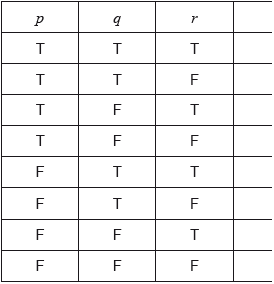 [2]
[2]
Use your truth table to determine whether the argument in part (a) is valid.
Give a reason for your decision.[2]
Write down the inverse of the argument in part (a)
(i) in symbolic form;
(ii) in words.[4]
Answer/Explanation
Markscheme
\((p \wedge q) \Rightarrow r\) (A1)(A1)(A1)
Notes: Award (A1) for conjunction seen, award (A1) for implication seen, award (A1) for correct simple propositions in correct order (the parentheses are required). Accept \(r \Leftarrow (p \wedge q)\).
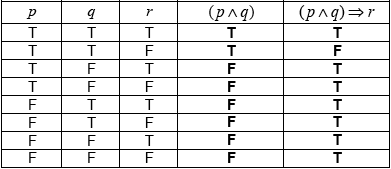 (A1)(ft)(A1)(ft)
(A1)(ft)(A1)(ft)
Notes: Award (A1)(ft) for each correct column, follow through to the final column from their \((p \wedge q)\) column. For the second (A1)(ft) to be awarded there must be an implication in part (a).
Follow through from part (a).
The argument is not valid since not all entries in the final column are T. (A1)(ft)(R1)
Notes: Do not award (A1)(ft)(R0). Follow through from part (b).
Accept “The argument is not valid since \((p \wedge q) \Rightarrow r\) is not a tautology”.
(i) \(\neg (p \wedge q) \Rightarrow \neg r\) (A1)(ft)(A1)(ft)
OR
\((\neg p \vee \neg q) \Rightarrow \neg r\) (A1)(ft)(A1)(ft)
Notes: Award (A1)(ft) for the negation of their antecedent and the negation of their consequent, (A1)(ft) for their fully correct answer.
Follow through from part (a). Accept \(\neg r \Leftarrow \neg (p \wedge q)\) or \(\neg r \Leftarrow (\neg p \vee \neg q)\). Follow through from part (a).
(ii) if it is not the case that the land has been purchased and the building permit has been obtained then the land can not be used for residential purposes. (A1)(A1)(ft)
OR
if (either) the land has not been purchased or the building permit has not been obtained then the land can not be used for residential purposes. (A1)(A1)(ft)
Notes: Award (A1) for “if… then…” seen, (A1)(ft) for correct statements in correct order. Follow through from part (d)(i).
Question
A water container is made in the shape of a cylinder with internal height \(h\) cm and internal base radius \(r\) cm.
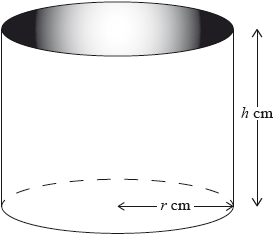
The water container has no top. The inner surfaces of the container are to be coated with a water-resistant material.
The volume of the water container is \(0.5{\text{ }}{{\text{m}}^3}\).
The water container is designed so that the area to be coated is minimized.
One can of water-resistant material coats a surface area of \(2000{\text{ c}}{{\text{m}}^2}\).
Write down a formula for \(A\), the surface area to be coated.[2]
Express this volume in \({\text{c}}{{\text{m}}^3}\).[1]
Write down, in terms of \(r\) and \(h\), an equation for the volume of this water container.[1]
Show that \(A = \pi {r^2}\frac{{1\,000\,000}}{r}\).[2]
Show that \(A = \pi {r^2} + \frac{{1\,000\,000}}{r}\).[2]
Find \(\frac{{{\text{d}}A}}{{{\text{d}}r}}\).[3]
Using your answer to part (e), find the value of \(r\) which minimizes \(A\).[3]
Find the value of this minimum area.[2]
Find the least number of cans of water-resistant material that will coat the area in part (g).[3]
Answer/Explanation
Markscheme
\((A = ){\text{ }}\pi {r^2} + 2\pi rh\) (A1)(A1)
Note: Award (A1) for either \(\pi {r^2}\) OR \(2\pi rh\) seen. Award (A1) for two correct terms added together.[2 marks]
\(500\,000\) (A1)
Notes: Units not required.[1 mark]
\(500\,000 = \pi {r^2}h\) (A1)(ft)
Notes: Award (A1)(ft) for \(\pi {r^2}h\) equating to their part (b).
Do not accept unless \(V = \pi {r^2}h\) is explicitly defined as their part (b).[1 mark]
\(A = \pi {r^2} + 2\pi r\left( {\frac{{500\,000}}{{\pi {r^2}}}} \right)\) (A1)(ft)(M1)
Note: Award (A1)(ft) for their \({\frac{{500\,000}}{{\pi {r^2}}}}\) seen.
Award (M1) for correctly substituting only \({\frac{{500\,000}}{{\pi {r^2}}}}\) into a correct part (a).
Award (A1)(ft)(M1) for rearranging part (c) to \(\pi rh = \frac{{500\,000}}{r}\) and substituting for \(\pi rh\) in expression for \(A\).
\(A = \pi {r^2} + \frac{{1\,000\,000}}{r}\) (AG)
Notes: The conclusion, \(A = \pi {r^2} + \frac{{1\,000\,000}}{r}\), must be consistent with their working seen for the (A1) to be awarded.
Accept \({10^6}\) as equivalent to \({1\,000\,000}\).[2 marks]
\(A = \pi {r^2} + 2\pi r\left( {\frac{{500\,000}}{{\pi {r^2}}}} \right)\) (A1)(ft)(M1)
Note: Award (A1)(ft) for their \({\frac{{500\,000}}{{\pi {r^2}}}}\) seen.
Award (M1) for correctly substituting only \({\frac{{500\,000}}{{\pi {r^2}}}}\) into a correct part (a).
Award (A1)(ft)(M1) for rearranging part (c) to \(\pi rh = \frac{{500\,000}}{r}\) and substituting for \(\pi rh\) in expression for \(A\).
\(A = \pi {r^2} + \frac{{1\,000\,000}}{r}\) (AG)
Notes: The conclusion, \(A = \pi {r^2} + \frac{{1\,000\,000}}{r}\), must be consistent with their working seen for the (A1) to be awarded.
Accept \({10^6}\) as equivalent to \({1\,000\,000}\).[2 marks]
\(2\pi r – \frac{{{\text{1}}\,{\text{000}}\,{\text{000}}}}{{{r^2}}}\) (A1)(A1)(A1)
Note: Award (A1) for \(2\pi r\), (A1) for \(\frac{1}{{{r^2}}}\) or \({r^{ – 2}}\), (A1) for \( – {\text{1}}\,{\text{000}}\,{\text{000}}\).[3 marks]
\(2\pi r – \frac{{1\,000\,000}}{{{r^2}}} = 0\) (M1)
Note: Award (M1) for equating their part (e) to zero.
\({r^3} = \frac{{1\,000\,000}}{{2\pi }}\) OR \(r = \sqrt[3]{{\frac{{1\,000\,000}}{{2\pi }}}}\) (M1)
Note: Award (M1) for isolating \(r\).
OR
sketch of derivative function (M1)
with its zero indicated (M1)
\((r = ){\text{ }}54.2{\text{ }}({\text{cm}}){\text{ }}(54.1926 \ldots )\) (A1)(ft)(G2)[3 marks]
\(\pi {(54.1926 \ldots )^2} + \frac{{1\,000\,000}}{{(54.1926 \ldots )}}\) (M1)
Note: Award (M1) for correct substitution of their part (f) into the given equation.
\( = 27\,700{\text{ }}({\text{c}}{{\text{m}}^2}){\text{ }}(27\,679.0 \ldots )\) (A1)(ft)(G2)[2 marks]
\(\frac{{27\,679.0 \ldots }}{{2000}}\) (M1)
Note: Award (M1) for dividing their part (g) by 2000.
\( = 13.8395 \ldots \) (A1)(ft)
Notes: Follow through from part (g).
14 (cans) (A1)(ft)(G3)
Notes: Final (A1) awarded for rounding up their \(13.8395 \ldots \) to the next integer.[3 marks]
Question
Consider these three propositions, in which x is a natural number.
\[\begin{array}{*{20}{l}} {p{\text{: }}x{\text{ is a factor of 60}}} \\ {q{\text{: }}x{\text{ is a multiple of 4}}} \\ {r{\text{: }}x{\text{ is a multiple of 5}}} \end{array}\]
Write down in symbolic form the compound proposition
“If \(x\) is a factor of 60 then \(x\) is a multiple of 5 or \(x\) is not a multiple of 4.”[3]
Write down in words the compound proposition \(\neg r \wedge (p\underset{\raise0.3em\hbox{$\smash{\scriptscriptstyle-}$}}{ \vee } q)\).[3]
Copy the following truth table and complete the last three columns.
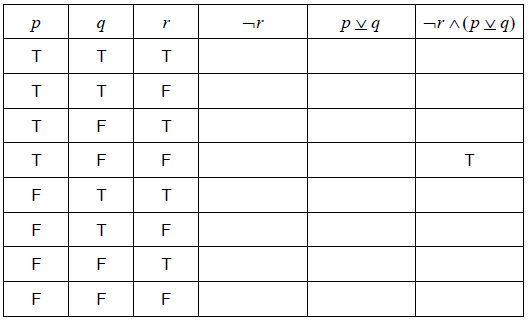 [3]
[3]
State why the compound proposition \(\neg r \wedge (p\underset{\raise0.3em\hbox{$\smash{\scriptscriptstyle-}$}}{ \vee } q)\) is not a logical contradiction.[1]
A row from the truth table from part (c) is given below.

Write down one value of \(x\) that satisfies these truth values.[1]
Answer/Explanation
Markscheme
\(p \Rightarrow (r \vee \neg q)\) (A1)(A1)(A1)
Note: Award (A1) for “\(p \Rightarrow \)”.
Award (A1) for “\(r \vee \neg q\)” or “\(r \vee q\)” (or “\(\neg q \vee r\)”or “\(q \vee r\)”)
Award (A1) for “\(\neg q\)”.
Award at most (A1)(A1)(A0) if parentheses are missing for \(r \vee \neg q\).
Award (A0)(A0)(A1) for \((p \Rightarrow r) \vee \neg q\).[3 marks]
\(x\) is not a multiple of 5 and (\(x\)) is (either) a factor of 60 or (\(x\)) is a multiple of 4, but not both (A1)(A1)(A1)
Note: Award (A1) for “\(x\) is not a multiple of 5”, (A1) for “(\(x\)) is a factor of 60 or (\(x\)) is a multiple of 4 but not both”, (A1) for “and” in the correct position. Accept only “but not both” in the second (A1).
Award at most (A1)(A1)(A0) for using extra statements such as “If …then”, “if and only if” etc.[3 marks]
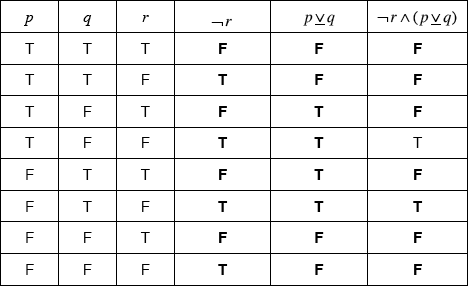 (A1)(A1)(A1)(ft)
(A1)(A1)(A1)(ft)
Note: Award (A1) for each correct column. Last column follows through from previous two.[3 marks]
because not all the entries in the \(\neg r \wedge (p\underset{\raise0.3em\hbox{$\smash{\scriptscriptstyle-}$}}{ \vee } q)\) column are F (R1)(ft)
Note: If all entries in the last column of their truth table are T, award (R1)(ft) for an answer of “it is a tautology”. Only award (R1)(ft) if the column is identified in the justification.[1 mark]
accept one of: 1\(\,\,\,\)OR\(\,\,\,\)2\(\,\,\,\)OR\(\,\,\,\)3\(\,\,\,\)OR\(\,\,\,\)6 (A1)
Note: Award (A1) for any one of the above answers.[1 mark]

